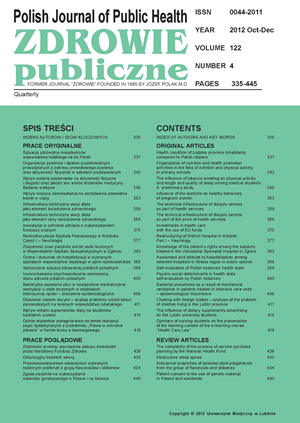Knowledge of the patient’s rights among the subjects treated in the Voivodship Specialist Hospital in Zgierz
DOI:
https://doi.org/10.12923/j.0044-2011/122-4/a.09Keywords:
patient’s rights, health information, educationAbstract
Introduction. Patients’ rights are closely related to and derived from the idea of human rights. The progresses of civilization as well as medical advances have contributed to the legal regulations, which are designed to protect the patients. Their knowledge is an important factor in the doctor-patient interaction, shaping the correct relationships and defining the behavior in problem situations. Knowledge of the patient’s rights allows you to fully benefit from health care services and prevent violations and negligence in relation to the patient.
Aim. Assessment of the knowledge of patients’ rights in the group of patients treated in the Voivodship Specialist Hospital in Zgierz.
Material and methods. The study was conducted using an anonymous questionnaire created by the authors. The study group consisted of 100 randomly selected adult patients of both sexes. The questionnaire included 23 questions on knowledge of the patient’s rights, methods of obtaining information on the patient’s rights, the patient’s rights violation, the acquisition of knowledge about the patient’s rights and socio-demographic data (gender, age and education of the respondents).
Results. The analysis of the results shows sufficient knowledge of patient’s rights, however, without going too much into details. The most common source of information about the patient’s rights in the opinion of respondents is television. Ninety four percent of them are convinced of the existence of the phenomenon of patient’s rights violations in Poland; 47% of the respondents have experienced it personally. Most violations concern the right to medical care and information.
Conclusions. The results point to the need for a better knowledge of the patient’s rights by both health professionals and the patients themselves.
References
1. Bujny J. Prawa pacjenta. Między autonomią a paternalizmem. Warszawa: C.H. Beck; 2007.
2. Boratyńska M, Konieczniak P. Prawa pacjenta. Warszawa: Difin; 2001.
3. Iwanowicz-Palus G. Prawa pacjenta w Polsce. Prawo i Medycyna. 2000;8(2):80.
4. Kujawa E. Prawa pacjenta – nowa rzeczywistość, nowe dylematy moralne. In: G. Rogala-Pawełczyk. Prawa pacjenta a etyka zawodowa pielęgniarki i położnej. Warszawa: Naczelna Rada Pielęgniarek i Położnych; 1998.
5. Lasocik Z. Edukacja w zakresie praw człowieka. In: A. Rzepliński. Prawa i wolności człowieka. Warszawa: Exit; 1993. p.125.
6. Drozdowska U. Cywilnoprawna ochrona praw pacjenta. Warszawa: C.H. Beck; 2007.
7. Poździoch S. Prawa człowieka i prawa pacjenta – osiągnięcia II połowy XX wieku. Zdrowie i Zarządzanie. 2001;2:17


